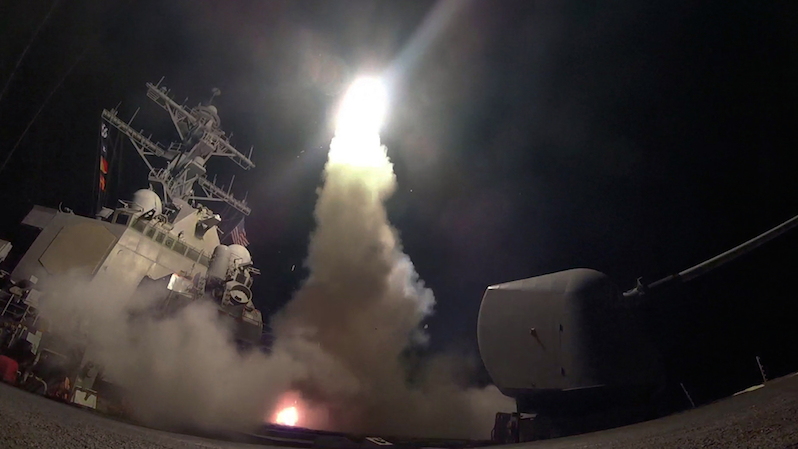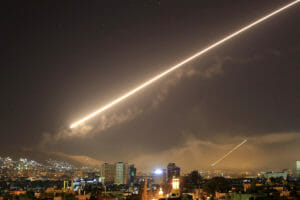Dereliction of Duty, Redux
All the evidence in Syria leads to an inescapable conclusion: The American military strike was a violation of international law. The guided-missile destroyer USS Porter launches a Tomahawk land attack missile aimed at Shayrat air base in Syria on April 6. (Mass Communication Specialist 3rd Class Ford Williams / U.S. Navy via AP)
1
2
3
4
The guided-missile destroyer USS Porter launches a Tomahawk land attack missile aimed at Shayrat air base in Syria on April 6. (Mass Communication Specialist 3rd Class Ford Williams / U.S. Navy via AP)
1
2
3
4
“There were also measures put in place,” McMaster noted, “to avoid hitting what we believe is a storage of sarin gas, so that that would not be ignited and cause a hazard to civilians or anyone else.” But this “belief” was driven by fundamentally flawed assertions derived from inconclusive and contradictory intelligence. Rather than knowing with absolute certainty the location of sarin storage units at Shayrat, intelligence analysts were asked to make their best guess as to where such storage sites could be located if they existed. This seems to be the extent of any second-tier analysis of the raw data used to sustain the U.S. contention Syria had employed sarin nerve agent from the Shayrat air base, designed not to confirm or deny the data in question, but rather incorporate them as fact into targeting decisions already made by the president.
The absolute dearth of viable intelligence to sustain the Trump administration’s case for unilateral military action against Syria completely undermines the moralistic posturing of Ambassador Haley, Secretary of State Rex Tillerson and the president himself about the need for action. There is no evidence that the Syria government engaged in any illegal activity in Khan Shaykhun, or anywhere else for that matter, especially with regard to its obligations under the CWC regarding the prohibition of chemical weapons. Void of this, the thin rationale the U.S. could have used to justify a military strike against Syria evaporates, leaving only one conclusion: The American military strike against Shayrat air base represents a violation of international law.
Not too many Americans will lose sleep over such a conclusion. Shayrat is back in operation, with the very SU-22 aircraft involved in the April 4 incident flying missions against targets in and around Khan Shaykhun. Having publicly committed to both the existence of sarin nerve agent at Shayrat and the possession of specific intelligence regarding the location of these weapons in the Shayrat facility, the U.S. has a moral obligation to insist on a full investigation of that facility in order to identify and eliminate these weapons. Otherwise, if Syria were to use these weapons in any future attack (bear in mind that Syria denies their existence), the U.S. would be as complicit as it claims Russia has been in facilitating the Syrian government’s possession and use of these illegal substances.
Such an investigation will never take place, for several reasons. First, the U.S. has zero intelligence that would sustain its allegation that Syria mounted an attack on Khan Shaykhun using sarin nerve agent from the Shayrat airfield. The American Fourth Estate should be demanding that the Trump administration back up its claims with something substantive, including annotated imagery showing where in Shayrat the sarin was stored, mixed and loaded into munitions—which should be very easy to do, since these areas were specifically designated not to be targeted in the first place.
But this is an image that does not exist, and indeed cannot exist, since the U.S. intelligence community has absolutely no information about any such activity at Shayrat. This reality not only exposes the Trump administration’s case against Syria as an absolute lie. It also exonerates Russia from the Trump administration’s charge that Moscow was complicit in the attack, given the presence of Russian personnel at Shayrat at the time.
In the aftermath of the cruise missile attack, and in response to Russia’s aggressive promulgation of a counternarrative placing the blame on Tahrir al-Sham, the White House on Tuesday published a declassified, four-page memorandum that sought to debunk the Russian claims and paint Russia as culpable in the chemical attack. The description of the intelligence underpinning the American assessment did not advance in any significant way what had already been released by the Trump administration. There was no new intelligence offered to prove that the U.S. narrative was accurate.
The White House claims the Syrian SU-22 was employed in response to an offensive launched by Tahrir al-Sham. The Syrian government account that its aircraft were targeting a weapons storage facility does not contradict this point. Of interest is the emphasis that the White House placed on an image, provided by anti-regime activists, of a crater in the middle of a road. The administration parroted the activist assessment that whatever caused this crater did not do any damage to surrounding buildings, and as such could not have caused the leaking of any chemical munitions stored there (although the militants maintain no such weapons exist). The White House memorandum also states that the crater was consistent with the impact of a chemical munition. In fact, the crater is consistent with the impact of a high explosive warhead from a mortar or air-to-surface rocket (as an artillery intelligence officer, I specialized in crater analysis of battlefield munitions).
However, geospacial analysis of the crater in question, with the impact points recorded on the video by activists, clearly shows that the crater cited by the White House was not affiliated with the strike carried out by the Syrian Air Force on the morning of April 4. Either the White House (and the U.S. intelligence community) has published a hasty and incorrect analysis, or the passage in question was deliberately released in an effort to mislead the American public. Again, one must wonder who is driving the White House narrative, given that so much of the assessment contained in the four-page memorandum was being driven by information released by Tahrir al-Sham.
The remainder of the White House memorandum is a replay of previous statements made by both the Trump and Obama administrations. It is curious that it stressed the unequivocal presence of sarin nerve agent based upon second- and third-hand reporting of symptoms. Similar diagnoses were made in the aftermath of the Ghouta attack in August 2013. International investigators later corrected the record, noting that some of the symptoms displayed by victims of that attack were indicative of exposure to some form of organophosphate, but stopped short of labeling the material involved as sarin.
That McMaster and the Trump administration feel confident in providing a specific diagnosis, without the kind of forensic investigation such conclusions normally require, is indicative of the rush to judgment that has been the norm when it comes to the incident at Khan Shaykhun.
Your support matters…
SUPPORT TRUTHDIG
Independent journalism is under threat and overshadowed by heavily funded mainstream media.
You can help level the playing field. Become a member.
Your tax-deductible contribution keeps us digging beneath the headlines to give you thought-provoking, investigative reporting and analysis that unearths what's really happening- without compromise.
Give today to support our courageous, independent journalists.





You need to be a supporter to comment.
There are currently no responses to this article.
Be the first to respond.